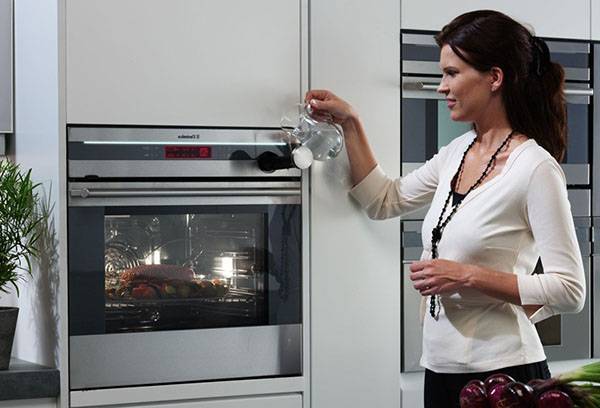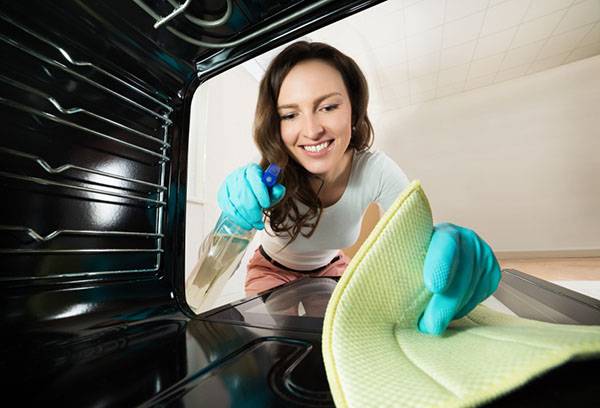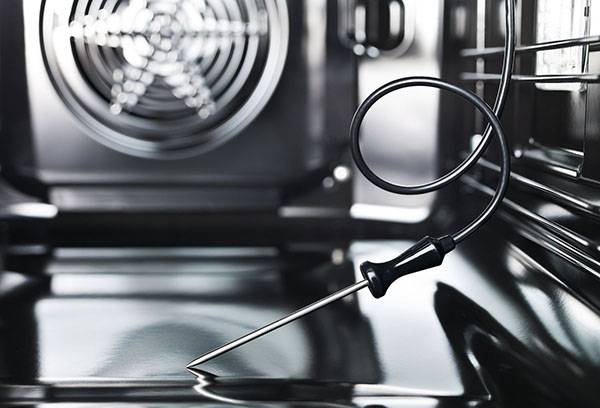The principle of hydrolysis oven cleaning and analysis of its effectiveness
What can you expect from an oven that includes hydrolytic oven cleaning: getting rid of problems with dried grease or disappointment? To answer this question, we will have to understand how such systems work and how they differ from other cleaning methods currently used by oven manufacturers.

How does the hydrolytic system work?
The oven cleaning system using water is not new at all and has been successfully used since the appearance of the first gas stoves. And no, we don't mean cleaning the walls and bottom with a sponge dipped in water: this strategy for fighting fat will require you to put in a lot of physical effort and also waste a lot of time. We are talking about hydrolysis. What it is? Just the process of decomposition of leftover food and fat under the influence of water.
How does the hydrolysis purification system work? In fact, it is quite primitive, which is both its plus and minus.
- Water is poured into a baking tray or a special recess in the amount required according to the instructions. Usually this is about half a liter.
- If desired, special powders or gels are added to the water to enhance the effect.
- Then the cleaning mode is turned on: the oven is heated to a certain temperature (from 50˚C to 90˚C - depending on the brand and model), and the process starts.
- The water vapor that appears 30-40 minutes after the temperature rises softens food residues and dirt, making them easy to remove from the enamel with a cloth.
- Yes, you will still have to work with your hands with such an oven cleaning system. Especially if the fat has managed to harden: here you will also have to arm yourself with cleaning agents and a sponge.
Advice
To make hydrolysis easier, look for ovens with enamel that can prevent the accumulation of fat.
Sounds familiar? Of course: people came up with this trick a long time ago! There is a good chance that you cleaned your old oven this way, only by manually controlling the process. Will the process become more automated if I buy an oven with a similar cleaning system? Perhaps the only advantage of the technology is the optimal choice of temperature and cleaning time specified by the designers. Otherwise, hydrolysis can be used to clean any ovens: even an old gas oven, an electric one without a cleaning system, or even a microwave oven.
Advice
When fat dries, its structure changes, and it will be simply unrealistic to soak it in one go. You will either have to repeat the procedure several times, or arm yourself with a metal sponge, using which you risk damaging the enamel. That’s why hydrolysis only really effectively deals with fresh dirt, which means you can’t delay cleaning the oven!
Hydrolysis or catalytic oven cleaning?
Not too impressed with hydrolysis, deciding that the automatic cleaning system is just a big word? Then you might want to consider a catalytic oven cleaner, which works by using chemical processes to break down grease into water, carbon (read: soot) and organic debris.
- Fat-absorbing porous enamel contains oxidizing agents that trigger the decomposition reaction of fat when the temperature rises.
- When the oven heats up to 140˚C, the process starts automatically, becoming more powerful closer to 200˚C. It turns out that the oven is cleaned right during cooking, which is very convenient, since there is no need to waste extra time and electricity.
- After cooking, when the stove has cooled down, all that remains is to remove the decomposition products from the oven, and you can enjoy the cleanliness!
Sounds high tech! The grease really doesn't have time to dry out, and the stove - both gas and electric - gets cleaned every time you cook. But this system has its disadvantages compared to hydrolysis.
- Catalytic oven cleaning increases the initial cost of the oven.
- Catalytic panels need to be replaced every 3-5 years depending on the frequency of use, as over time they lose their grease-absorbing properties.
- Catalytic panels are not installed on the doors and on the bottom of ovens, so these elements will have to be washed manually, and not without the help of the same hydrolysis.
Important!
Do not allow dairy or sweet products to get on the panels: in places where they are dirty, they will stop reacting with fat.
Hydrolytic or pyrolytic oven cleaning?
Is there a better system than hydrolysis or catalytic purification? There is, and it's called pyrolysis. At the moment, this oven cleaning system is the most effective, which, of course, cannot but affect its price. But what is so special about it?
- Pyrolysis ensures the decomposition of food debris and fat due to high temperatures, or, to put it more clearly, it simply burns all contaminants on the walls.
- To do this, the oven is heated in the range from 250˚C to 500˚C, plus special enamel is used that can withstand such temperatures.
- All dirt burns to ashes on the walls, bottom and door, and after the oven cools down, all that remains is to remove the ash. And this is a matter of five minutes!
Here's a mini-crematorium in your kitchen. However, despite its effectiveness, using this system will not always be convenient.
- Such cabinets are much more expensive due to the technology and quality of the materials used, and they are also only available as electric ones.
- Accordingly, calcination becomes an additional item of energy consumption, especially if the oven does not have level pyrolysis, which allows you to set the temperature below 500˚C. In addition, during cleaning, due to the burning smell, the hood will operate in the most powerful mode.
- Strong heating of the sides of the oven can shorten the service life of the furniture adjacent to it.
By the way
The system locks the door during cleaning for your safety, so there is nothing to be afraid of.
It turns out that hydrolysis is not so bad after all, especially for those who are economical and do not cook too often, but the ideal cleaning system has not yet been developed. And finally, a little advice for the lazy: use baking sleeves, foil and special oven lids, and you won’t have to waste effort, time, electricity and fabulous money on manual cleaning or automatic cleaning systems.

